Maternal Child Nursing Care > TEST BANKS > Test Bank for Saunders Comprehensive Maternal and Child Review 2025/2026 Summary and Review well An (All)
Test Bank for Saunders Comprehensive Maternal and Child Review 2025/2026 Summary and Review well Analyzed answers
Document Content and Description Below
MATERNITY NURSING amniotic fluid The pale, straw-colored fluid in which the fetus floats. It serves as a cushion against injury from sudden blows or movements and helps maintain a constant body te... mperature for the fetus. The fetus modifies the amniotic fluid through the processes of swallowing, urinating, and movement through the respiratory tract. Ballottement Rebounding of the fetus against the examiner's finger on palpation. When the examiner taps the cervix, the fetus floats upward in the amniotic fluid. The examiner feels a rebound when the fetus falls back. Chadwick's sign Bluish coloration of the mucous membranes of the cervix, vagina, and vulva that occurs at about 6 weeks of pregnancy and is a probable sign of pregnancy. Delivery Actual event of birth; the expulsion or extraction of the neonate. Embryo Stage of fetal development that lasts from day 15 until approximately 8 weeks after conception or until the embryo measures 3 cm from crown to rump. Fertilization Uniting of the sperm and ovum, which occurs within 12 hours of ovulation and within 2 to 3 days of insemination, the average duration of viability for the ovum and sperm. Goodell's sign Softening of the cervix that occurs at the beginning of the second month of gestation and is a probable sign of pregnancy. Gravid A pregnant woman; called gravida I (primigravida) during the first pregnancy, gravida II during the second, and so on. Hegar's sign Compressibility and softening of the lower uterine segment that occurs at about week 6 of gestation; a probable sign of pregnancy. Implantation Attachment of the zygote to the uterine wall 6 to 10 days after conception. Infant A baby born alive; also, a baby from 28 days of age until the first birthday. Labor Coordinated sequence of involuntary uterine contractions resulting in effacement and dilation of cervix, followed by expulsion of the products of conception. lecithin (L)-to-sphingomyelin (S) ratio The ratio of two components of amniotic fluid, used for predicting fetal lung maturity; the normal L/S ratio in amniotic fluid is 2:1 or higher when the fetal lungs are mature. Lochia Discharge from the uterus that consists of blood from the vessels of the placental site and debris from the decidua; lasts for 2 to 3 weeks after delivery. Nġgele's rule Determines the estimated date of confinement and works on the premise that the woman has a 28-day menstrual cycle. Add 7 days to the first day of the last menstrual period. Subtract 3 months and add 1 year. Alternatively, add 7 days to the last menstrual period and count forward 9 months. Neonate A human offspring from the time of birth to the twenty-eighth day of life; also called newborn. Newborn A human offspring from the time of birth to the twenty-eighth day of life; also called neonate. Oligohydramnios An abnormally small amount or absence of amniotic fluid; associated with fetal renal abnormalities. Parity The number of pregnancies that have been carried to viability. Placenta The organ that provides for the exchange of nutrients and waste products between the fetus and the mother, Downloaded by Morris Muthii (muthiimorris68@gmail.com) produces hormones to maintain pregnancy, and develops by the third month of gestation; also called afterbirth. Quickening First perception of fetal movement, appearing usually in the sixteenth to twentieth week of pregnancy. Surfactant Phospholipid that is necessary to keep the fetal lung alveoli from collapsing; amount is usually sufficient after 32 weeks' gestation. Uterus Located behind the symphysis pubis, between the bladder and the rectum. It is comprised of four parts—fundus (upper part), corpus (body), isthmus (lower segment), and cervix. Vagina A tubular structure located behind the bladder and in front of the rectum; extends from the cervix to the vaginal opening in the perineum. It functions as the outflow tract for menstrual fluid and for vaginal and cervical secretions, the birth canal, and the organ for coitus. Viability The capability of the fetus to survive outside the uterus; about 22 to 24 weeks after the last menstrual period, or fetal weight more than 500 g. Chapter 22 Female Reproductive System I. REPRODUCTIVE STRUCTURES (Fig. 22-1) A. Ovaries 1. Form and expel ova 2. Secrete estrogen and progesterone B. Fallopian tubes 1. Muscular tubes (oviducts) approximate to the ovaries and connect to the uterus 2. Tubes that propel the ova from the ovaries to the uterus C. Uterus 1. A muscular, pear-shaped cavity in which the fetus develops 2. The cavity from which menstruation occurs D. Cervix II. MENSTRUAL CYCLE (Box 22-1) BOX 22-1 Menstrual Cycle OVARIAN CHANGES Preovulatory Phase The hypothalamus releases gonadotropin-releasing hormone through the portal system to the anterior pituitary system. Secretion of follicle-stimulating hormone (FSH) by the anterior lobe of the pituitary gland stimulates growth of follicles. Most follicles die, leaving one to mature into a large graafian follicle. 1. The internal os of the cervix opens into the body of the uterine cavity. 2. The cervical canal is located between the internal os and the external os. 3. The external cervical os opens into the vagina. E. Vagina 1. A muscular tube that extends from the cervix to the vaginal opening in the perineum 2. Known as the birth canal 3. Passage between the cervical os and the external environment a. Passageway for menstrual blood flow b. Passageway for fetus c. Passageway for penis for intercourse Estrogen produced by the follicle stimulates increased secretions of luteinizing hormone (LH) by the anterior lobe of the pituitary gland. The follicle ruptures and releases an ovum into the peritoneal cavity. Luteal Phase The luteal phase begins with ovulation. Body temperature drops and then rises by 0.5° to 1° F around the time of ovulation. Corpus luteum is formed from follicle cells that remain in the ovary following ovulation. Corpus luteum secretes estrogen and progesterone during the remaining 14 days of the cycle. Downloaded by Morris Muthii (muthiimorris68@gmail.com) Corpus luteum degenerates if the ovum is not fertilized, and secretion of estrogen and progesterone declines. The decline of estrogen and progesterone stimulates the anterior pituitary to secrete more FSH and LH, initiating a new reproductive cycle. UTERINE CHANGES Menstrual Phase The menstrual phase consists of 4 to 6 days of bleeding as the endometrium breaks down because of the decreased levels of estrogen and progesterone. The level of FSH increases, enabling the beginning of a new cycle. Proliferative Phase The proliferative phase lasts about 9 days. Estrogen stimulates proliferation and growth of the endometrium. A. Ovarian hormones As estrogen increases, it suppresses secretion of FSH and increases secretion of LH. Secretion of LH stimulates ovulation and the development of the corpus luteum. Ovulation occurs between days 12 and 16. The estrogen level is high and the progesterone level is low. Secretory Phase The secretory phase lasts about 12 days and follows ovulation. This phase is initiated in response to the increase in LH level. The graafian follicle is replaced by the corpus luteum. The corpus luteum secretes progesterone and estrogen. Progesterone prepares the endometrium for pregnancy if a fertilized ovum is implanted. 1. Ovarian hormones include the follicle-stimulating hormone (FSH) and luteinizing hormone (LH). 2. The hormones are released by the anterior pituitary gland. 3. The hormones produce changes in the ovaries. 4. Secretion of ovarian hormones leads to changes in the endometrium. 5. The menstrual cycle, the regularly recurring physiological changes in the endometrium that culminate in its shedding, may vary in length, with the average length being about 28 days. B. Ovarian changes 1. Preovulatory phase 2. Luteal phase III. FEMALE PELVIS AND MEASUREMENTS A. True pelvis 1. Lies below the pelvic brim 2. Consists of the pelvic inlet, midpelvis, and pelvic outlet C. Types of pelvis 1. Gynecoid a. Normal female pelvis b. Transversely rounded or blunt c. Most favorable for successful labor and birth 2. Anthropoid a. Oval shape b. Adequate outlet, with a normal or moderately narrow pubic arch D. Pelvic inlet diameters 1. Anteroposterior diameters C. Uterine changes 1. Menstrual phase 2. Proliferative phase 3. Secretory phase B. False pelvis 1. Is the shallow portion above the pelvic brim 2. Supports the abdominal viscera 3. Android a. Wedge-shaped or angulated b. Seen in males c. Not favorable for labor d. Narrow pelvic planes can cause slow descent and midpelvic arrest. 4. Platypelloid a. Flat with an oval inlet b. Wide transverse diameter but short anteroposterior diameter, making the outlet inadequate a. Diagonal conjugate: Distance from the lower margin of the symphysis pubis to the sacral promontory b. True conjugate or conjugate vera: Distance from the upper margin of the symphysis pubis to the sacral promontory c. Obstetric conjugate: The smallest front-to-back distance through which the fetal head must pass in moving through the pelvic inlet 2. Transverse diameter: The largest of the pelvic inlet diameters; located at right angles to the true conjugate 3. Oblique (diagonal) diameter: Not clinically measurable 4. Posterior sagittal diameter: Distance from the point where the anteroposterior and transverse diameters cross each other to the middle of the sacral promontory E. Pelvic midplane diameters 1. Transverse diameter (interspinous diameter) 2. Midplane normally is the largest plane and has the longest diameter IV. FERTILIZATION AND IMPLANTATION A. Fertilization 1. Fertilization occurs in the upper region of the fallopian tubes F. Pelvic outlet diameters 1. Transverse (intertuberous diameter) 2. Outlet presents the smallest plane of the pelvic canal 2. It occurs within 12 hours of ovulation and within 2 to 3 days of insemination, the average durations of viability for the ovum and sperm. 3. It takes place when sperm and ovum unite. 4. Once fertilized, the membrane of the ovum undergoes changes that prevent entry of other sperm. 5. Each reproductive cell carries 23 chromosomes. 6. Sperm carry an X or a Y chromosome—XY, male; XX, female. B. Implantation 1. Zygote is propelled toward the uterus. 2. Zygote implants 6 to 8 days after ovulation. 3. Blastocyst secretes chorionic gonadotropin to ensure that the corpus luteum remains viable and secretes estrogen and progesterone for the first 2 to 3 months of gestation. Downloaded by Morris Muthii (muthiimorris68@gmail.com) V. FETAL DEVELOPMENT (Box 22-2) BOX 22-2 Fetal Development EMBRYONIC PERIOD (weeks 3 through 8) Week 1 Blastocyst is free-floating. Weeks 2 to 3 Embryo is 2 mm in length. Groove forms along middle of back. Blood circulation begins. Heart is tubular. Week 5 Embryo is 4 to 6 mm in length. Embryo is 0.4 g. Double heart chambers are visible. Heart begins to beat. Limb buds form. Week 8 Embryo is 3 cm in length. Embryo is 2 g. Eyelids begin to fuse. Circulatory system through umbilical cord is well established. Every organ system is present. FETAL PERIOD (week 9 to birth) Week 12 Fetus is 8 cm in length. Fetus is 45 g. Face is well formed Limbs are long and slender. Kidneys begin to form urine. Spontaneous movements occur. Heartbeat is detected by Doppler transducer between 10 and 12 weeks. Sex is visually recognizable. Week 16 Active movements are present. Fetal skin is transparent. Lanugo hair begins to develop. Skeletal ossification occurs. Week 20 Fetus is 19 cm in length. Fetus is 465 g. Lanugo covers the entire body. Fetus has nails. Muscles are developed. Enamel and dentin are depositing. Heartbeat is detected by regular (nonelectronic) fetoscope. Week 24 Fetus is 28 cm in length. Fetus is 780 g. Hair on head is well formed. Skin is reddish and wrinkled. Reflex hand grasp functions. Vernix caseosa covers entire body. Fetus has ability to hear. Week 28 Fetus is 38 cm in length. Fetus is 1200 g. Limbs are well flexed. Brain is developing rapidly. Eyelids open and close. A. Preembryonic period: First 2 weeks after conception B. Embryonic period: Beginning of the third through the eighth week after conception C. Fetal period: Beginning of the ninth week after conception and ending with birth VI. FETAL ENVIRONMENT A. Amnion 1. Encloses the amniotic cavity. Lungs are developed sufficiently to provide gas exchange (lecithin forming). If born, neonate can breathe at this time. Week 32 Fetus is 40 cm in length. Fetus is 2000 g. Bones are fully developed. Subcutaneous fat has collected. The L/S (lecithin-to-sphingomyelin) ratio is 1.2:1. Week 36 The fetus is 42 to 48 cm in length. The fetus is 2500 g. The skin is pink and the body is rounded. The skin is less wrinkled. Lanugo is disappearing. The L/S ratio is higher than 2:1. Week 40 The fetus is 48 to 52 cm in length. The fetus is 3000 to 3600 g. The skin is pinkish and smooth. Lanugo is present on upper arms and shoulders. Vernix caseosa decreases Fingernails extend beyond fingertips. Sole (plantar) creases run down to the heel. The testes are in the scrotum. The labia majora are well developed. 2. Is the inner membrane that forms about the second week of embryonic development 3. Forms a fluid-filled sac that surrounds the embryo and later the fetus B. Chorion 1. Is the outer membrane 2. Becomes vascularized and forms the fetal part of the placenta C. Amniotic fluid 1. Consists of 800 to 1200 mL by the end of pregnancy 2. Surrounds, cushions, and protects the fetus and allows for fetal movement 3. Maintains the body temperature of the fetus 4. Consists largely of fetal urine and is therefore a measure of fetal kidney function 5. The fetus modifies the amniotic fluid through the processes of swallowing, urinating, and movement through the respiratory tract. D. Placenta 1. The placenta provides for exchange of nutrients and waste products between the fetus and mother 2. It develops by the third month. 3. It depends on maternal circulation. 4. It produces hormones to maintain pregnancy and assumes full responsibility for the production of these hormones by the twelfth week of gestation. 5. Large particles such as bacteria cannot pass through the placenta. 6. Nutrients, drugs, antibodies, and viruses can pass through the placenta. 7. In the third trimester, transfer of maternal immunoglobulin provides the fetus with passive immunity to certain diseases for the first few months after birth. 8. By week 8, genetic testing can be done. VII. FETAL CIRCULATION A. Umbilical cord 1. It contains two arteries and one vein. 2. The arteries carry deoxygenated blood and waste products from the fetus. 3. The vein carries oxygenated blood and provides oxygen and nutrients to the fetus. B. Fetal heart rate 1. The fetal heart rate (FHR) depends on gestational age; the fetal heart rate is 160 to 170 beats/min in the first trimester but slows with fetal growth to 120 to 160 beats/min near or at term. 2. The fetal heart rate is about twice the maternal heart rate. C. Fetal circulation bypass (Fig. 22-2) 1. Fetal circulation bypass is present because of nonfunctioning lungs. 2. Bypasses must close following birth to allow blood to flow through the lungs and the liver. 3. The ductus arteriosus connects the pulmonary artery to the aorta, bypassing the lungs. 4. The ductus venosus connects the umbilical vein and the inferior vena cava, bypassing the liver. 5. The foramen ovale is the opening between the right and left atria of the heart, bypassing the lungs. Downloaded by Morris Muthii (muthiimorris68@gmail.com) [Show More]
Last updated: 4 months ago
Preview 5 out of 55 pages

Loading document previews ...
Buy this document to get the full access instantly
Instant Download Access after purchase
Buy NowInstant download
We Accept:

Reviews( 0 )
$8.00
Can't find what you want? Try our AI powered Search
Document information
Connected school, study & course
About the document
Uploaded On
Apr 01, 2025
Number of pages
55
Written in
Additional information
This document has been written for:
Uploaded
Apr 01, 2025
Downloads
0
Views
14

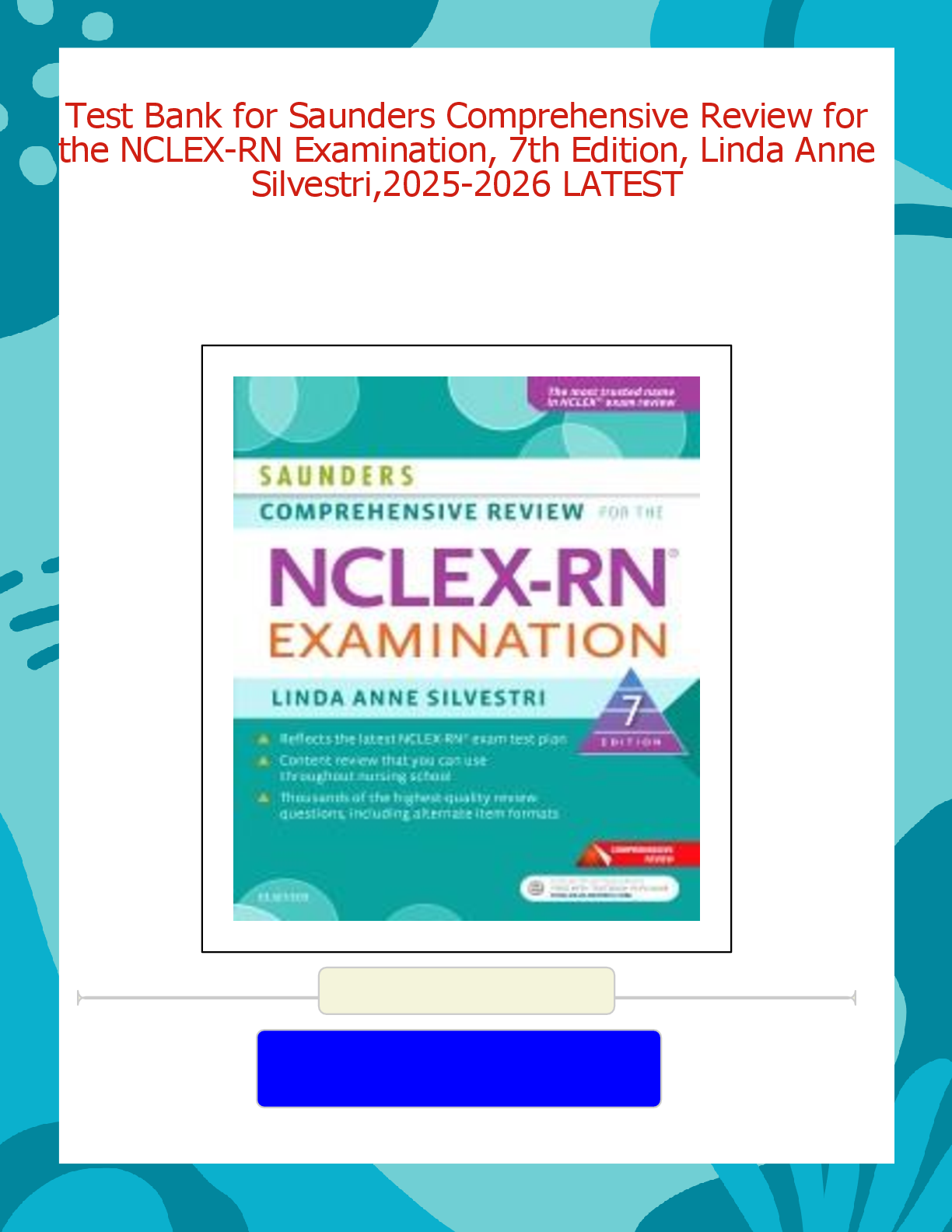


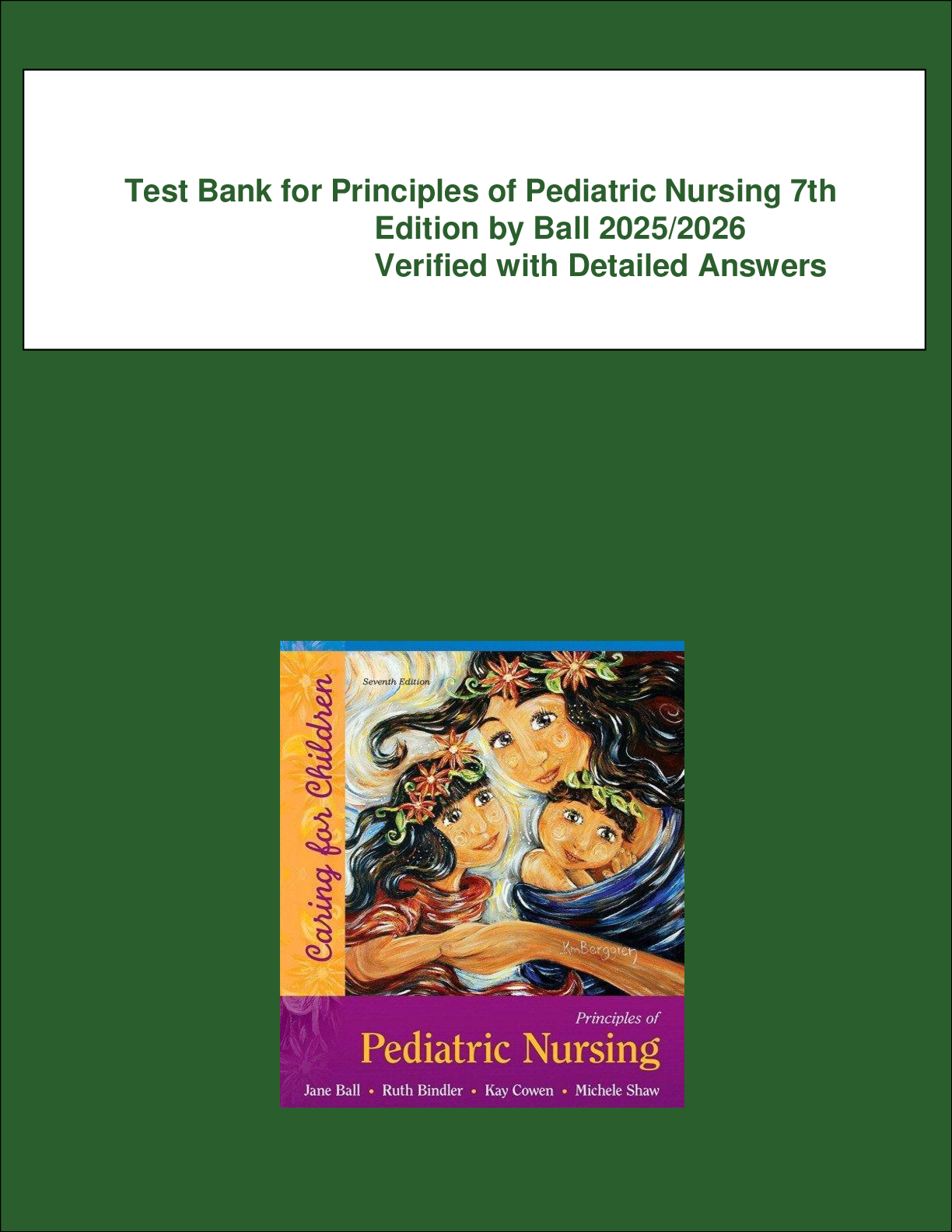

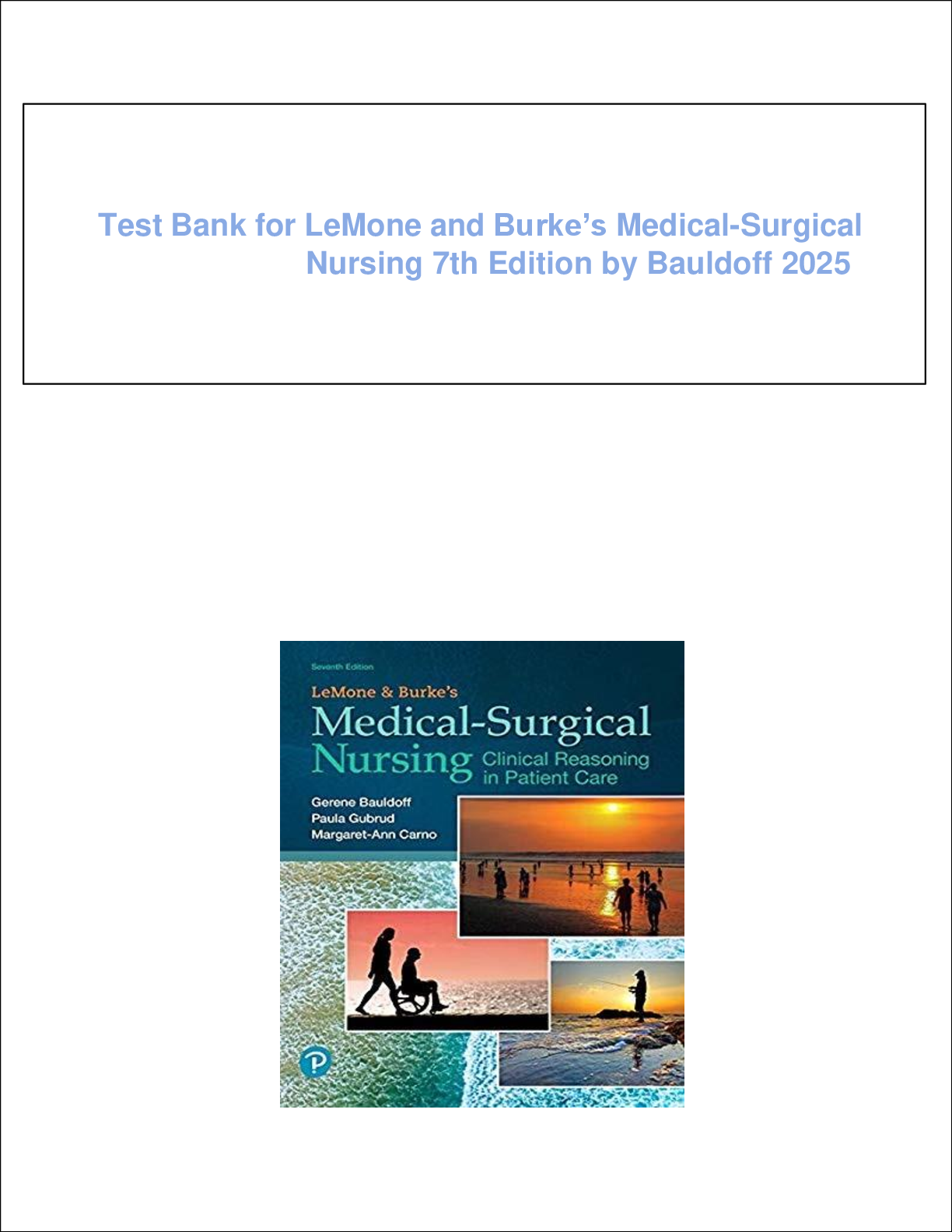
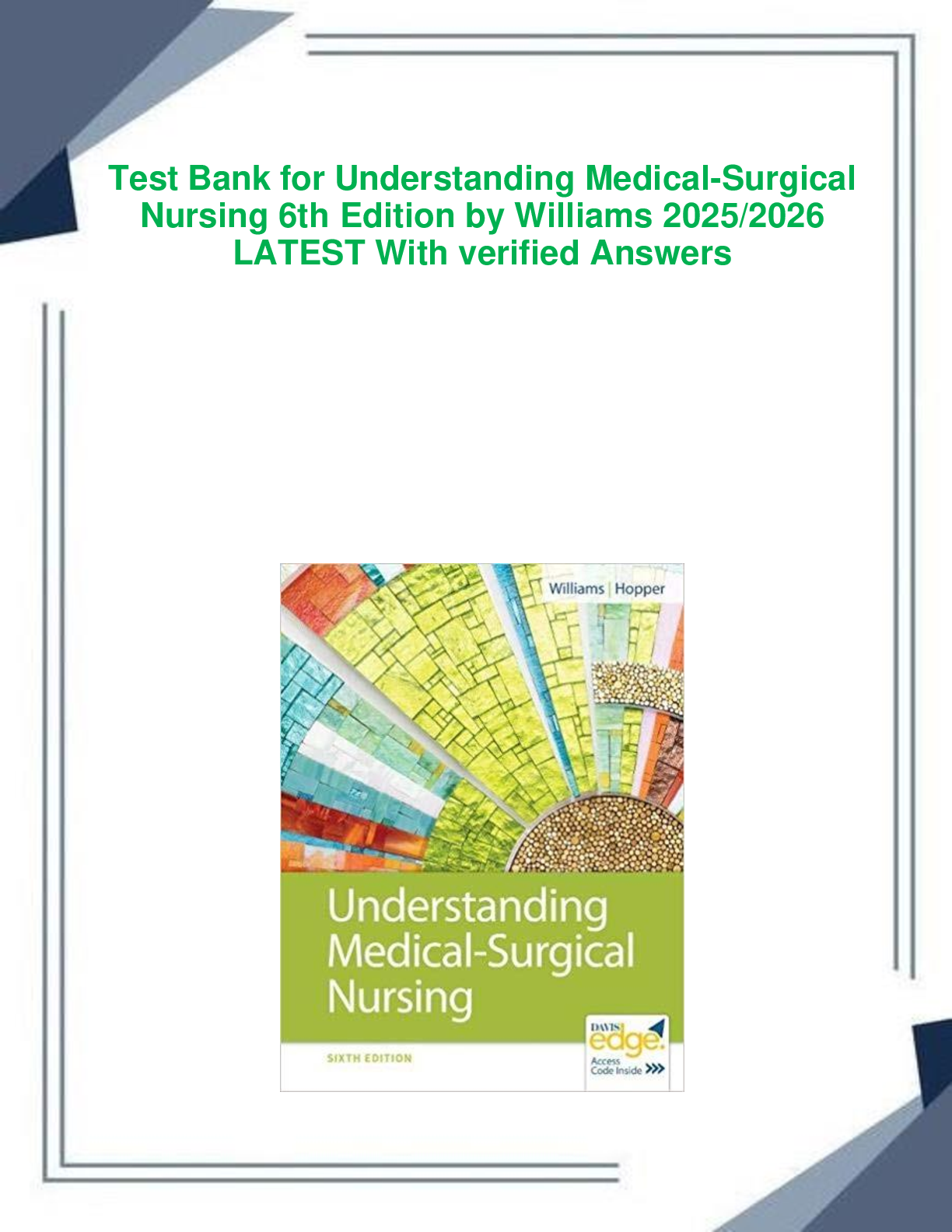

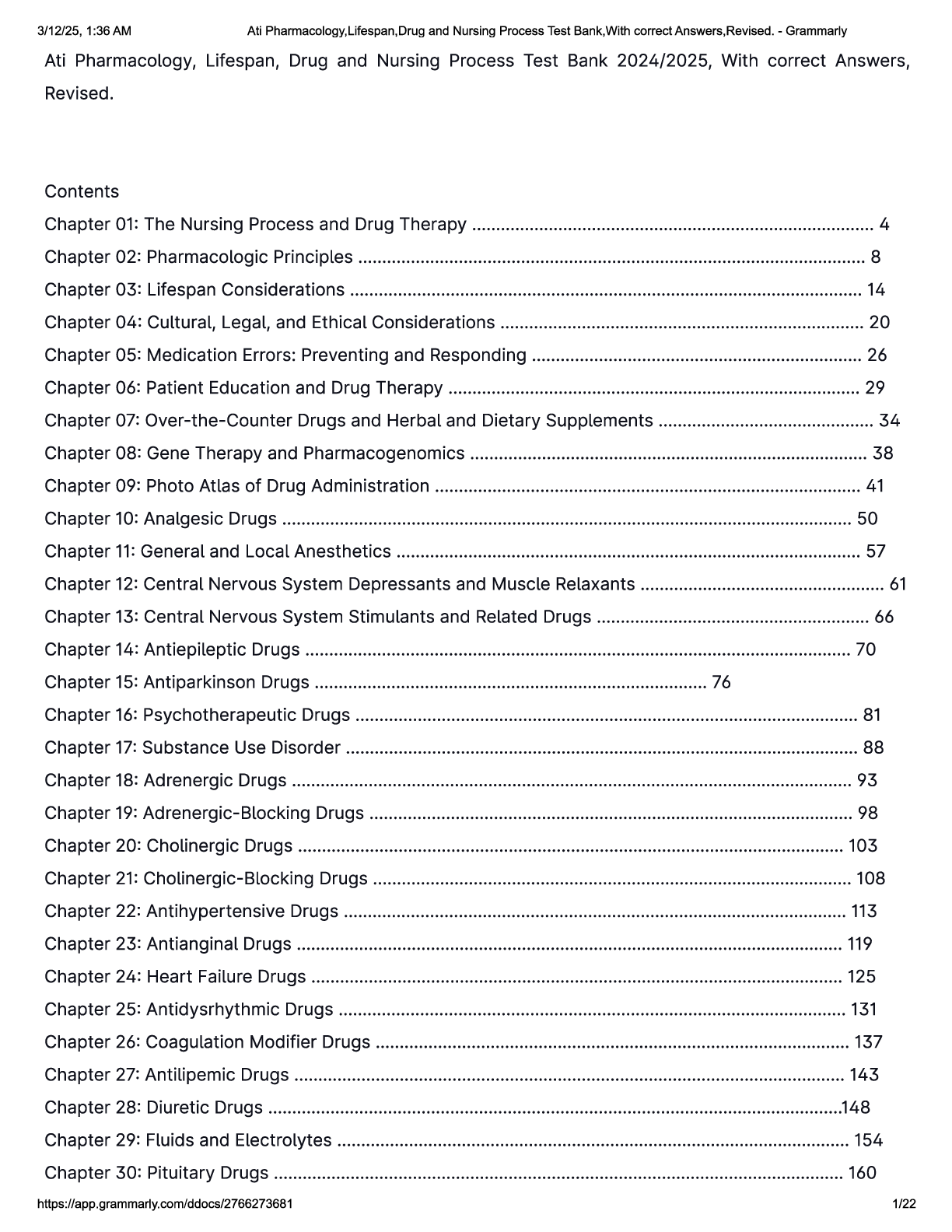
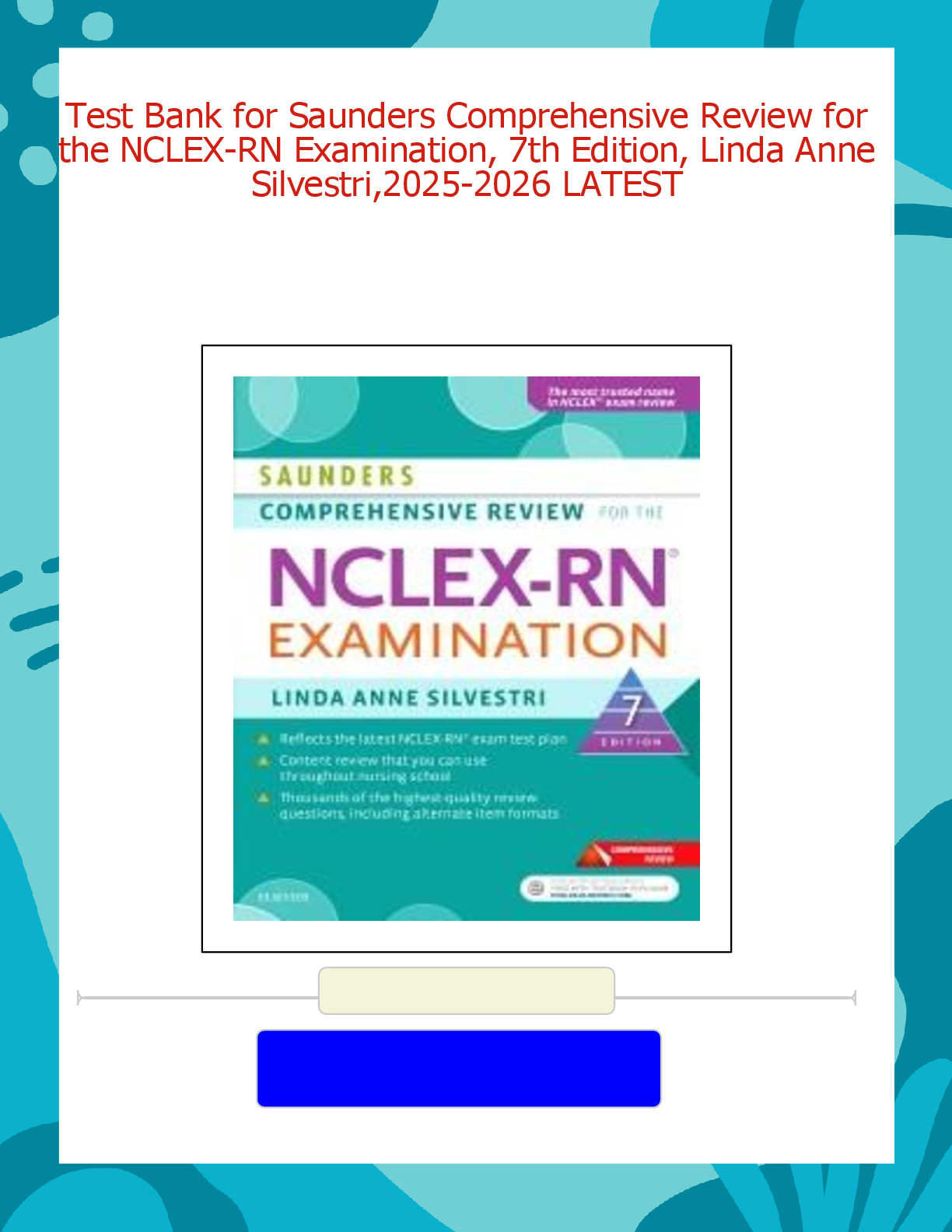
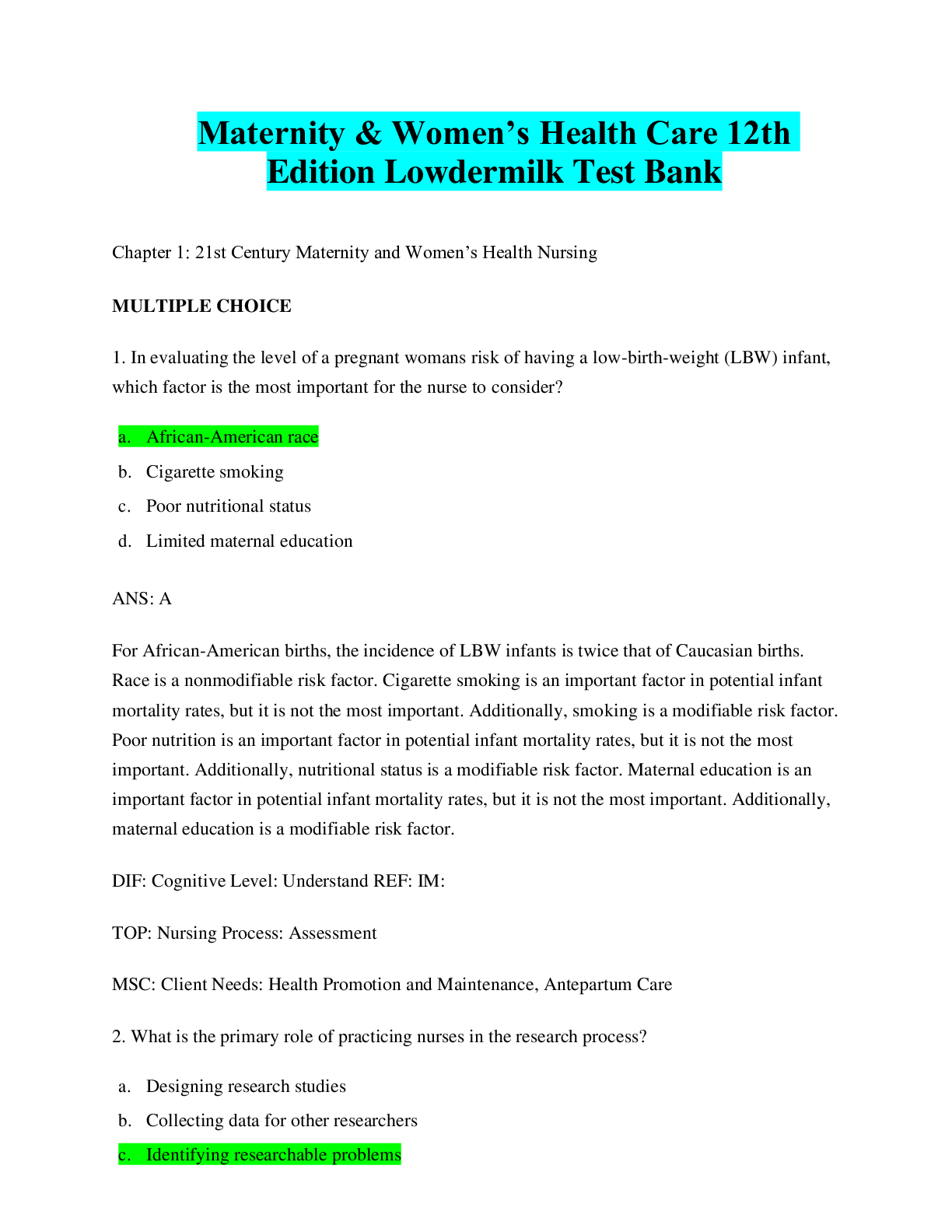

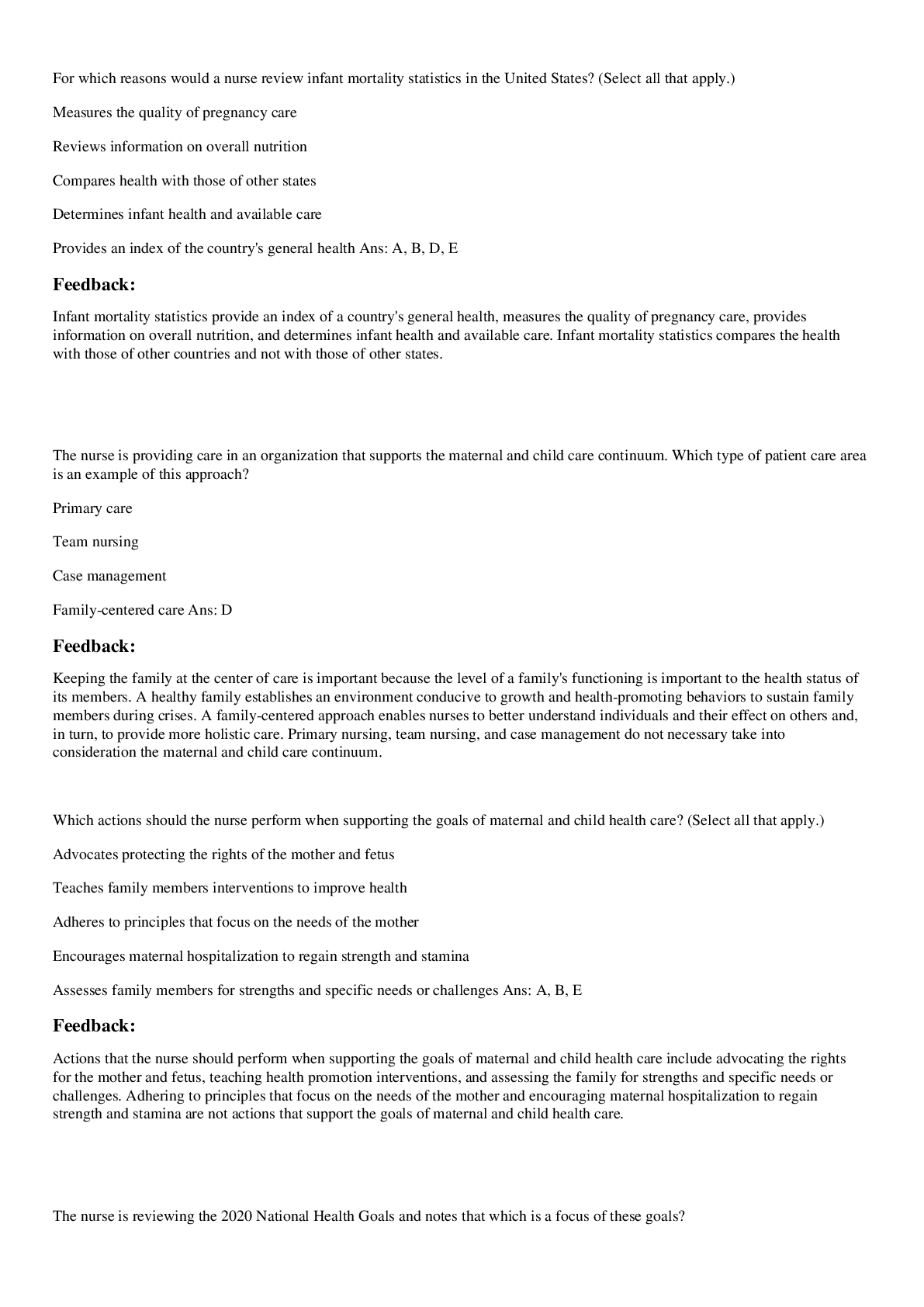

.png)



